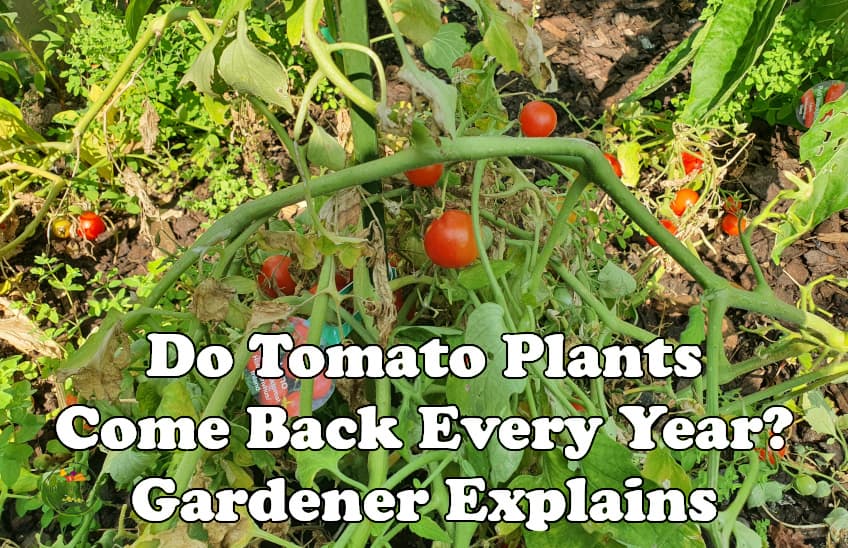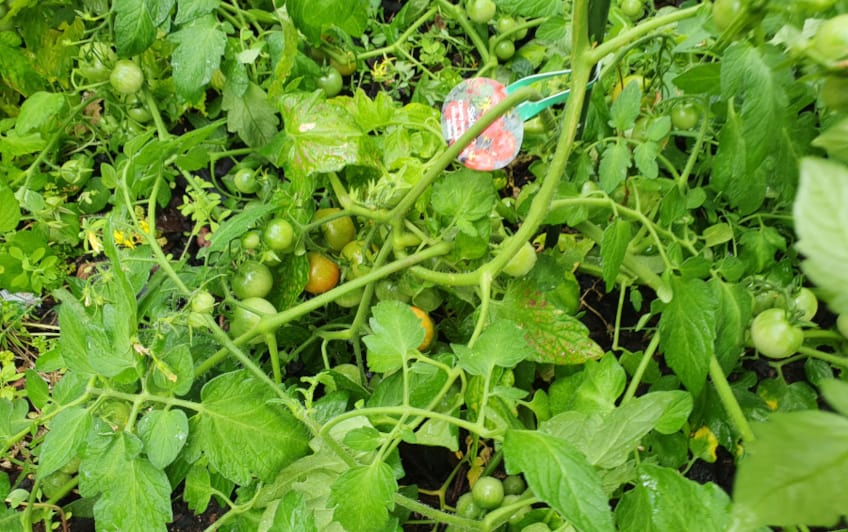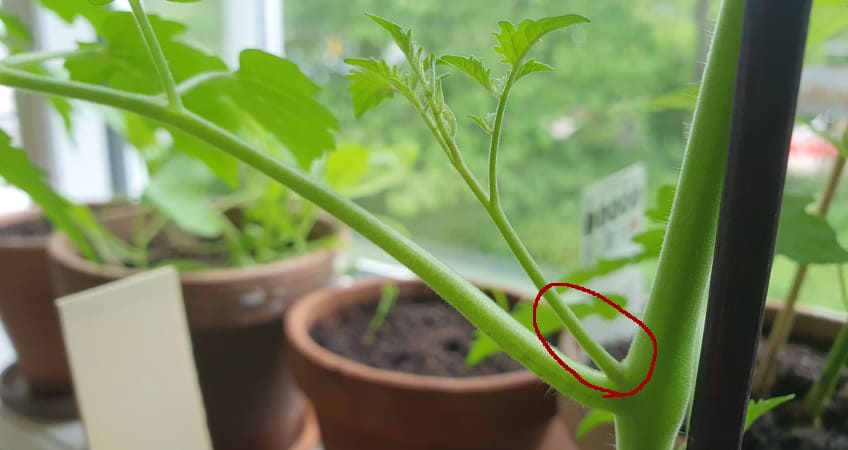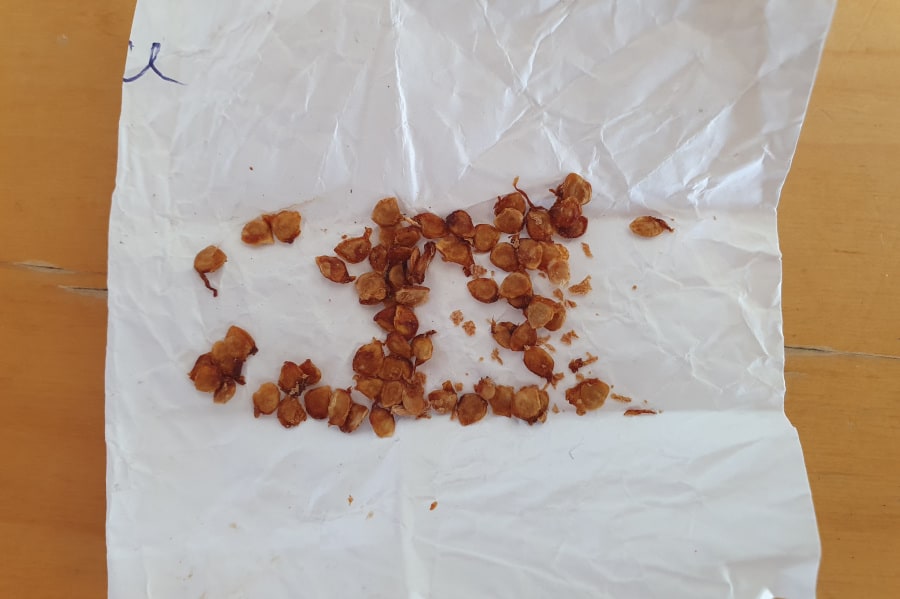This post contains affiliate links.
I have read a lot of conflicting information about whether tomato plants are annuals or perennials and whether they come back every year or not. To find out for sure, I visited my local garden center to talk to one of the gardeners about it. This article covers what I learned
Most tomato varieties are perennials, meaning they can live for several years. In most parts of the world, however, tomato plants are grown as annuals since they cannot survive frost. So while most tomato plants are perennials, they are usually only grown as such in their native tropical regions.
In this article, I share some cool tips about how you can keep your tomato plants alive for as long as possible, perhaps even through winter, that the kind gardener I talked to at the garden center taught me. I have started implementing them myself and they work great.
I also explain how you can keep growing new plants from just one tomato plant by taking cuttings, how to collect tomato seeds and more.

Do Tomato Plants Grow Back Every Year? Expert Explains
Before I wrote this article, I went to my local garden center to talk to one of their gardeners. When I asked him if there is a way to make tomato plants grow back every year, he told me the following.
“Tomato plants cannot survive frost so they will not grow back every year after a cold winter. If they are not exposed to frost and gets enough direct sunlight, however, many tomato plants can live and produce fruit for several years since it is technically a perennial plant.”
I usually remove my plants entirely after the first night with frost and then I plant new tomatoes again in the spring as soon as I am sure, there is no risk of frost.
Another thing I sometimes like to do is to collect seeds. It’s very easy and it allows you to grow more tomatoes next year without having to buy more seeds or plants. Collecting seeds is an excellent way to save money on gardening, although there is a chance that the plant you grow from the seeds won’t be the exact same variety as the plant you collected the seeds from.
I will explain exactly how you can collect seeds from tomatoes and why you can’t be sure that you will get the same variety later in this post so feel free to skip ahead if that’s what you want to learn.
Tips for Keeping Tomato Plants Alive All Year

While it is technically possible to keep a tomato plant alive all year, it is probably not worth it. At least in most parts of the world. The plants won’t survive outside in the winter when there is frost and since they also need quite a lot of sunlight, you will most likely need artificial grow lights to keep them alive.
If you live in an area where you don’t experience frost and have a lot of sunlight even in the winter, however, you could most likely keep your tomato plants alive for several years.
Some tomato varieties can grow and produce fruit for several years if they have the right conditions. This includes sunlight for 6-8 hours per day, plenty of water, and temperatures that never get below 32°F (0°C) and ideally stay between 55-85°F (around 13-30°C) which is where tomatoes thrive the most.
I have made this quick and easy overview of the ideal growing conditions for tomato plants:
| Temperature | 55-85°F (around 13-30°C) |
| Sunlight | Direct sun for 6-8 hours per day |
| Water | Daily. Ideally in the morning |
It is technically also possible to keep tomato plants alive in areas that do experience frost and short days.
Just make sure you bring them inside and give them the conditions they need. This is definitely easier if you grow your tomatoes in pots rather than in the ground but even then, they generally won’t produce nearly as many or as good tomatoes as they do outside in direct sunlight.
I usually plant tomatoes as early as possible in the spring when I’m sure there is no risk of frost and until as late as possible in the fall. I don’t grow tomatoes indoors in the winter since it requires a lot of space.
To keep tomato plants alive during the winter in areas that experience frost and short days, you need to bring the plants inside and provide them with grow light for 6-8 hours per day, temperatures of 55-85°F (around 13-30°C), and plenty of space and water.
If you want to keep your tomato plants alive for a long time, I recommend growing indeterminate tomato plants since they have a much longer lifespan than determinate varieties and also keep producing fruit even after you harvest. You can read more about that on this link.
What is the Lifespan of a Tomato Plant?
The lifespan of a tomato plant depends on the variety and the growing conditions but the most important factor that determines how long a tomato plant can live is the weather since tomatoes cannot withstand frost.
Tomato plants usually live between 6-8 months since they require warm weather and direct sunlight. Tomatoes cannot withstand frost so they die in the winter in most areas. In areas that do not experience frost, most tomatoes can grow as perennials and live for many years.
As I mentioned a bit earlier in this post, an excellent way to be able to grow more tomato plants is to take cuttings and grow them as new plants. You can technically keep growing tomatoes forever this way as long as they have the right growing conditions.
Keep a Tomato Plant Alive Forever by Taking Cuttings (Cloning)

Taking cuttings from your tomato plants and growing them as new plants is a type of cloning.
Cloning tomato plants essentially allows you to grow as many genetically identical tomato plants as you want. This also means that you can grow the exact same tomato variety for as long as you want, as long there is enough light. The best part is that you only need a single tomato plant to get started.
Cloning a tomato plant is surprisingly easy. Here is how you do it:
- Identify a branch or sucker on your tomato plant (see photo above).
- Cut the branch or sucker off using clean and sharp pruning shears.
- Place the cutting in a tall glass of water so the stem is submerged but the leaves are above water.
- Change the water every 2-3 days for 2-3 weeks until roots grow from the stem.
- Plant the rooted cutting in a pot or the ground. and water it.
If you want a more detailed guide with photos of all the steps, head over to this article where I show you precisely how to do it.
Always use clean and sharp pruning shears when you take cuttings to reduce the risk of introducing pests or diseases to your plant. Pruning shears can be bought cheaply and don’t have to be super fancy or anything. I bought these recently and highly recommend them if you don’t already have some.
How to Collect Seeds From Your Tomato Plants

Tomato seeds are really easy to collect and save and in my experience, absolutely worth it if you have a plant you like. Since bees and other pollinators spread pollen, you might get a variety with slightly different genetics than the plant you collected the seeds from, but it is still a lot of fun and a good way to get more tomatoes for free.
Tomato plants don’t depend on bees and other pollinators to produce fruit, so you can also grow tomatoes and collect seeds in places with no pollinator insects. You can read more about that here.
One single fruit from a tomato plant can contain more than one hundred seeds so even if they don’t all sprout, you can have enough seeds for several years from just one tomato.
The easiest way to save tomato seeds is to squeeze the seeds from a fresh tomato onto a piece of paper. Let the seeds dry for a week and then put them in a bag or a container where they can be kept dry and in darkness until you need them.
After collecting the seeds and letting them dry, the result should look like the photo above.
Then next spring when you determine that the risk of frost is sufficiently low, just plant your seeds and watch your new plants grow.
To get the most fruit (and thereby seeds) from your tomato plants, I recommend that you learn a bit about what happens when tomato plants flower and why they do it. I have a whole article with everything you should know about that, which you can find here.
Do Tomato Plants Grow Back If You Cut Them At The Ground?
You probably shouldn’t cut your tomatoes all the way down to the ground but there are, however, some reasons why it might make sense to do anyway.
If your plants have grown too large for the place where you have them or if they have been severely damaged by the weather or something else, you could consider cutting them close to the ground since there is a chance they will grow back.
Some tomato plants can grow back if you cut them at the ground as long as they have enough space, the temperatures are high enough and they receive plenty of direct sunlight, nutrients, and water. Indeterminate tomato plants are more likely to grow back than determinate plants since they have a longer lifespan.
If you try this, there must be at least a few months left of the growing season since it takes a while for the plants to grow back.
I found this excellent video where a man makes this exact experiment. He does a much better job of explaining the process than I ever could so I highly recommend that you take a look at his video.

